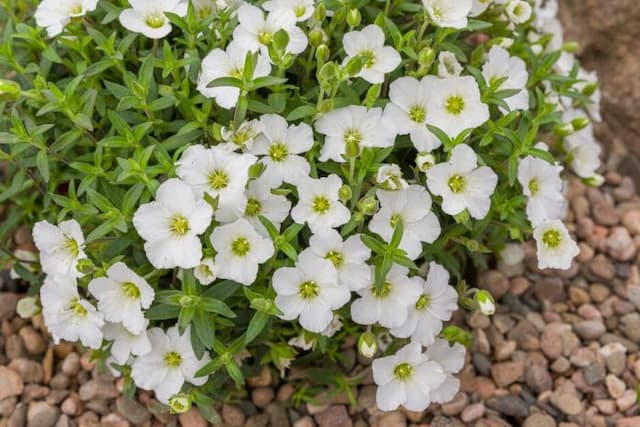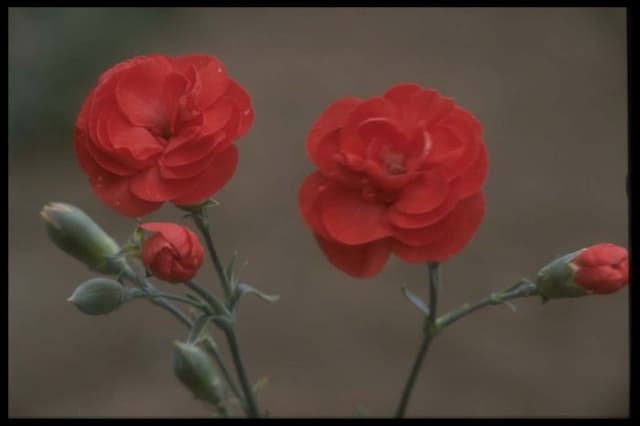Sweet William Dianthus 'David Russell' (b)

ABOUT
Dianthus 'David Russell' is a captivating plant with a distinctive appearance. Its lush foliage is slender and blue-green in color, providing a striking contrast to its blossoms. The flowers themselves are a standout feature, showcasing bold, velvety petals that are usually a vibrant pink or red, often with darker or lighter accents adorning the edges, making for a striking display. These petals typically form a pattern almost resembling a frilly skirt, giving the blooms a beautifully ruffled look. The center of each flower is often a contrasting eye, catching the attention of onlookers and adding depth to the flower's overall aesthetics. Moreover, these blooms can be appreciated for their delightful fragrance, which is both sweet and spicy, contributing to the sensory appeal of the plant. The Dianthus 'David Russell' is a popular choice for gardeners looking to add a splash of color and elegance to their floral arrangements or garden beds.
About this plant
 Names
NamesSynonyms
Sweet William, Garden Pink, Carnation
Common names
Dianthus 'David Russell'
 Toxicity
ToxicityTo humans
The Dianthus 'David Russell', commonly referred to as pinks, is not generally known to be toxic to humans. There are no significant reports of poisoning or toxic effects from ingesting parts of this plant. However, it's always advisable to exercise caution and avoid eating ornamental plants as they are not intended for consumption.
To pets
Pinks are not generally considered toxic to pets. There is no common documentation of them causing poisoning or severe health issues in domestic animals such as cats and dogs. Nonetheless, ingestion of non-food plants can sometimes cause mild stomach upset in pets, so it is still wise to monitor your pet and keep ornamental plants out of their reach when possible.
 Characteristics
CharacteristicsLife cycle
Perennials
Foliage type
Evergreen
Color of leaves
Green
Flower color
Pink
Height
1 foot 9 inches (53 centimeters)
Spread
1 foot (30 centimeters)
Plant type
Herb
Hardiness zones
5
Native area
Europe
Benefits
 General Benefits
General Benefits- Attracts Pollinators: The bright and vibrant flowers of the Dianthus 'David Russell', commonly known as Pinks, attract bees and butterflies, which are essential for the pollination of plants and the overall health of gardens.
- Aesthetic Appeal: Adds a splash of color to gardens with its beautiful pink flowers, enhancing the visual appeal of landscaping.
- Low Maintenance: Once established, Pinks are drought-tolerant and do not require frequent watering, making them an ideal choice for gardeners seeking low-maintenance plants.
- Cut Flowers: The flowers of Pinks have a long vase life, making them an excellent choice for cut flower arrangements.
- Fragrance: Pinks are known for their spicy, clove-like fragrance, which can add a delightful scent to gardens and cut flower bouquets.
- Seasonal Interest: They bloom in late spring to early summer, adding interest to the garden at a time when many other plants are just starting to grow.
- Versatility: Pinks are suitable for a variety of garden settings, including borders, rockeries, and containers.
- Evergreen Foliage: Many Dianthus varieties, including Pinks, have evergreen foliage that provides year-round interest, even when the plants are not in bloom.
- Deer Resistance: Pinks are generally resistant to deer, making them a good choice for gardens in areas with high deer populations.
 Medical Properties
Medical PropertiesThis plant is not used for medical purposes.
 Air-purifying Qualities
Air-purifying QualitiesThis plant is not specifically known for air purifying qualities.
 Other Uses
Other Uses- Dye Production: The petals of pinks can be used to create a subtle dye for fabrics, offering shades from pink to light yellow depending on mordants used.
- Garden Borders: Due to its compact growth habit, the plant can serve as an excellent border for garden walkways or flower beds.
- Edible Decorations: The flowers of pinks are edible and can be used to decorate cakes or desserts for an added touch of elegance and a hint of clove-like flavor.
- Companion Planting: Pinks can be planted among vegetables to attract beneficial insects like bees for pollination and deter some pests.
- Culinary Infusions: The flowers can be steeped in sugar syrup or vinegar to infuse them with the flower's essence, which can then be used in various culinary creations.
- Bookmarks and Art: Dry the flowers and press them to create attractive bookmarks or to embellish handmade cards and other paper crafts.
- Plant Potpourri: Dried petals of pinks can be added to potpourri mixes for aesthetic purposes and to give a pleasant fragrance to rooms.
- Photography Prop: Due to their attractiveness, pinks can be used as props in photography, particularly in garden and nature-related photo shoots.
- Scented Sachets: Dried petals and leaves can be filled into small sachets to create closet and drawer fresheners.
- Wedding Confetti: The petals, being biodegradable and colorful, can serve as an environmentally friendly confetti option at weddings.
Interesting Facts
 Feng Shui
Feng ShuiThe Carnation is not used in Feng Shui practice.
 Zodiac Sign Compitability
Zodiac Sign CompitabilityThe Carnation is not used in astrology practice.
 Plant Symbolism
Plant Symbolism- Love: Generally, Dianthus flowers, including the 'David Russell' variety, symbolize love and affection. The name "Dianthus" itself is derived from the combination of Greek words "dios" (god) and "anthos" (flower), which translates to "the flower of the gods", hinting at a divine affection.
- Admiration: Like many other flowers, Dianthus 'David Russell' can express admiration. Its vibrant colors and pleasant fragrance often convey a message of esteem or high regard.
- Fidelity: Dianthus flowers are often associated with faithfulness. The 'David Russell' variety, with its enduring beauty, may be given to represent someone's commitment to a person or cause.
- Passion: The rich hues of the Dianthus 'David Russell' can evoke feelings of passion, making them a fitting choice for romantic occasions.
- Boldness: The bright colors and striking patterns of this type of Dianthus may symbolize boldness or audacity, making a statement in gardens and floral arrangements.
 Water
WaterPinks, the common name for Dianthus 'David Russell', should be watered when the top inch of soil feels dry to the touch. This typically means you might need to water them once or twice a week, depending on the climate and weather conditions. Use room temperature water and gently water the soil at the base of the plant, avoiding wetting the foliage to prevent fungal diseases. The amount of water required will depend on the size of the plant and the pot, but a good guideline is to use about 16-24 ounces every time you water, ensuring the water drains through the bottom of the container. During the winter, when the plant is not actively growing, reduce watering to prevent root rot.
 Light
LightPinks prefer full sunlight to thrive, so it's best to place Dianthus 'David Russell' in a spot where they can receive at least six hours of direct sunlight daily. An ideal spot would be a south-facing garden bed or a sunny window if grown indoors. They can tolerate light shade, especially in areas with very hot summers, but too much shade can lead to spindly growth and reduced flowering.
 Temperature
TemperaturePinks are quite hardy and can tolerate a range of temperatures, but they perform best in cooler conditions. They can survive in temperatures as low as 40°F and as high as 80°F. However, the ideal temperature range for Dianthus 'David Russell' is between 60°F and 70°F. Extreme temperatures above 85°F or below freezing can damage or kill the plant.
 Pruning
PruningPinks should be pruned to promote bushy growth and to remove spent flowers, which encourages further blooming. Deadheading, or the removal of faded flowers, should be done regularly throughout the blooming season. At the end of the blooming season, cut back the stems to within a few inches of the ground to maintain a compact form and to rejuvenate the plant for the next growing season. The best time for a major pruning is in early spring.
 Cleaning
CleaningAs needed
 Soil
SoilThe best soil mix for the Sweet William variant Dianthus 'David Russell' consists of a well-draining peaty or sandy loam with an addition of organic matter, such as compost or well-rotted manure. It thrives in a slightly alkaline to neutral pH range, ideally between 6.7 and 7.3.
 Repotting
RepottingSweet William plants typically do not require frequent repotting and can thrive in the same pot for several years. You should consider repotting every 2-3 years to refresh the soil and provide nutrients.
 Humidity & Misting
Humidity & MistingSweet William prefers moderate humidity levels but is quite adaptable and can tolerate both dry and more humid conditions as long as there is good air circulation around the plants.
 Suitable locations
Suitable locationsIndoor
Place in sunny spot with well-draining soil and water when topsoil is dry.
Outdoor
Full sun or partial shade, in well-draining, fertile soil.
Hardiness zone
3-9 USDA
 Life cycle
Life cycleThe Dianthus 'David Russell', commonly known as 'Perpetual Carnation', begins its life cycle with seed germination, which occurs in moist, well-draining soil in a warm environment. Following germination, the seedling emerges and develops true leaves, growing into a vegetative state characterized by a dense clump of grassy, blue-green foliage. As the plant matures, it enters the flowering stage, producing long-lasting fragrant blooms that are pink to purple in color, typically from late spring through summer. After pollination, which can be facilitated by insects, the flowers will produce seeds, enabling the cycle to restart. To maintain vigor, Perpetual Carnations can be propagated through cuttings or division, ensuring continued growth. This plant may go dormant or semi-dormant in colder seasons, only to resume growth with the return of favorable conditions in the spring.
 Propogation
PropogationPropogation time
Early spring
Propogation: The Dianthus 'David Russell', commonly known as Pinks, is typically propagated during late spring to early summer when the plant is actively growing. The most popular method of propagation for Pinks is through cuttings. To do this, a gardener should select healthy non-flowering stems and cut them to a length of about 4 to 6 inches (10 to 15 centimeters). It's important to make a clean cut just below a node. The lower leaves of the cuttings are removed and the stem is inserted into a well-draining soil mix. The soil should be kept moist but not waterlogged to encourage rooting. Rooting hormone can be applied to the cut end to increase the success rate, but it's not always necessary. Cuttings typically root within 2 to 4 weeks, at which point they can be transplanted to their final location.


![Pink [Tequila Sunrise]](/_next/image?url=https%3A%2F%2Fplants-admin.emdemapps.com%2Fimages%2Fplants%2F%2Fimages%2F604b5d995d06e.png&w=640&q=75)






